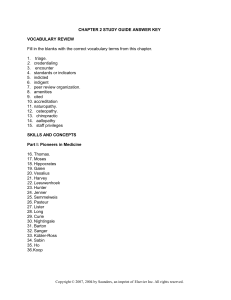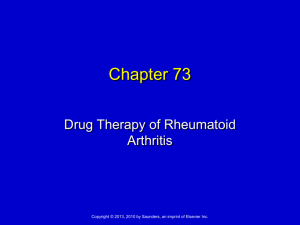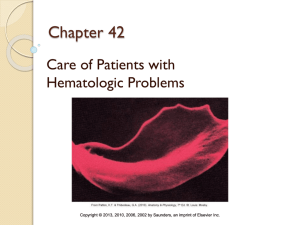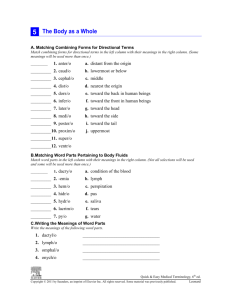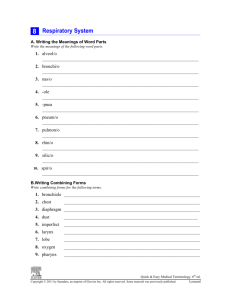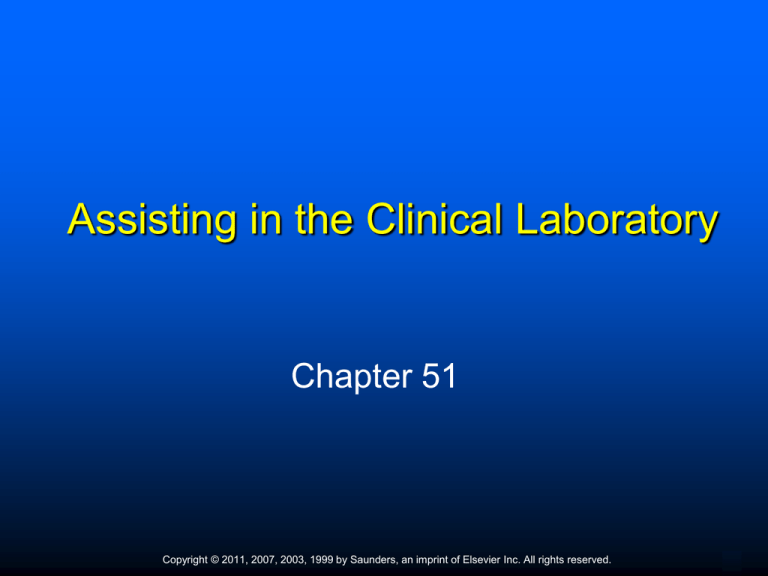
Assisting in the Clinical Laboratory
Chapter 51
Copyright © 2011, 2007, 2003, 1999 by Saunders, an imprint of Elsevier Inc. All rights reserved.
1
Learning Objectives
Define, spell, and pronounce the terms listed in the
vocabulary.
Apply critical thinking skills in performing patient
assessment and care.
Discuss the role of the clinical laboratory in patient
care and the medical assistant’s role in coordinating
laboratory tests and results.
Describe the divisions of the clinical laboratory, and
give an example of a test performed in each division.
Describe the Clinical Laboratory Improvement
Amendments (CLIA) and how they influence
laboratory testing.
Copyright © 2011, 2007, 2003, 1999 by Saunders, an imprint of Elsevier Inc. All rights reserved.
2
Learning Objectives
Explain the three CLIA regulatory categories.
Compare and contrast the agencies that govern or
influence practice in the clinical laboratory,
including the CDC, OSHA, EPA, CLSI, and CAP.
Summarize techniques to minimize physical,
chemical, and biological risks in the clinical
laboratory.
Describe the essential elements of a laboratory
requisition.
Display sensitivity to patient rights and feelings in
collecting specimens.
Copyright © 2011, 2007, 2003, 1999 by Saunders, an imprint of Elsevier Inc. All rights reserved.
3
Learning Objectives
Explain the chain of custody, and illustrate why it
is important.
Compare and contrast quality assurance and
quality control.
Describe the differences between Greenwich
time and military time.
Identify the Fahrenheit temperature and Celsius
temperature of common laboratory equipment.
Name the metric units used for measuring liquid
volume, distance, and mass.
Copyright © 2011, 2007, 2003, 1999 by Saunders, an imprint of Elsevier Inc. All rights reserved.
4
Learning Objectives
Describe the proper use of pipets.
Explain how dilutions are prepared.
Name the parts of a microscope, and
describe their functions.
Summarize selected microscopy tests that
can be performed in the ambulatory care
setting.
Demonstrate the proper use of the
microscope.
Describe the safe use of a centrifuge.
Copyright © 2011, 2007, 2003, 1999 by Saunders, an imprint of Elsevier Inc. All rights reserved.
5
The Role of the Clinical Laboratory
Laboratory medicine or clinical pathology is the
medical discipline that applies clinical laboratory
science and technology to the care of patients.
The laboratory is the place in which a collected
specimen is analyzed and evaluated.
Tests are performed manually (by hand) or
through automation (by using specialized
instruments).
Copyright © 2011, 2007, 2003, 1999 by Saunders, an imprint of Elsevier Inc. All rights reserved.
6
Personnel in the Clinical Laboratory
Pathologist
Certified medical technologists (MTs)
Certified medical laboratory technicians (MLTs)
or medical laboratory assistants (MLAs)
Certified medical assistants (CMAs)
Laboratory assistants
Phlebotomists
Copyright © 2011, 2007, 2003, 1999 by Saunders, an imprint of Elsevier Inc. All rights reserved.
7
Clinical Laboratory Testing
Provides essential data needed for the diagnosis
and management of a patient’s condition
Abnormal values for a particular test may be seen
with more than one pathological condition.
Screening test (qualitative) – results are reported as
positive or negative.
Quantitative test – has units attached to numeric
values; values are identified as the amount of
analyte per given volume of specimen; the results
must be reported with the appropriate units.
Copyright © 2011, 2007, 2003, 1999 by Saunders, an imprint of Elsevier Inc. All rights reserved.
8
Critical Thinking Application
The referral laboratory telephones to report
the values on several tests performed on the
urine of a client, Cecelia Roberts. Marsha jots
down the following: Total protein, 0.12; Occult
blood, positive; Albumin, 50; Glucose, 120.
What is wrong with the notations she has just
made? Are these tests qualitative or
quantitative?
Copyright © 2011, 2007, 2003, 1999 by Saunders, an imprint of Elsevier Inc. All rights reserved.
9
The Clinical Laboratory
Improvement Amendments (CLIA)
Establish quality standards for all laboratory
testing to ensure the accuracy, reliability, and
timeliness of patient test results regardless of
where the test was performed
Requires all laboratories to register and meet
federal requirements
Copyright © 2011, 2007, 2003, 1999 by Saunders, an imprint of Elsevier Inc. All rights reserved.
10
Food and Drug Administration (FDA)
Assigns commercially marketed in vitro
diagnostic test systems to three different CLIA
regulatory categories based on their potential
risk to public health:
Waived tests
Moderate-complexity tests
High-complexity tests
Copyright © 2011, 2007, 2003, 1999 by Saunders, an imprint of Elsevier Inc. All rights reserved.
11
Waived Tests
Employ methodologies that are so simple and
accurate as to render the likelihood of
erroneous results by the user negligible
or
Are tests that the Secretary has determined
pose no unreasonable risk of harm to the
patient if performed incorrectly
Copyright © 2011, 2007, 2003, 1999 by Saunders, an imprint of Elsevier Inc. All rights reserved.
12
Moderate- and High-Complexity Tests
Moderate-complexity: Hematology
and chemistry testing, Gram staining, and
microscopic analysis of urine sediment
High-complexity tests usually are not
performed in a POL
Papanicolaou (Pap) smear analysis, blood typing
and cross-matching, and cytology testing
Copyright © 2011, 2007, 2003, 1999 by Saunders, an imprint of Elsevier Inc. All rights reserved.
13
Laboratory Requirements
Subject to inspections every 2 years
Maintain integrity and ID of patient specimens
Quality-control and quality-assurance
procedures
Proficiency tests – quality-control tests that must be
performed three times/year
Copyright © 2011, 2007, 2003, 1999 by Saunders, an imprint of Elsevier Inc. All rights reserved.
14
Medical Assistant Role
The medical assistant may perform all
CLIA-waived and some moderate-complexity
tests.
The medical assistant may be involved in the
collection of specimens for high-complexity
testing.
Copyright © 2011, 2007, 2003, 1999 by Saunders, an imprint of Elsevier Inc. All rights reserved.
15
Divisions of the Clinical Laboratory
Hematology
Chemistry
Microbiology
Specimen collection
and processing
Blood bank
Coagulation
Serology
Histology
Cytology
Toxicology
Urinalysis
Special chemistry
Copyright © 2011, 2007, 2003, 1999 by Saunders, an imprint of Elsevier Inc. All rights reserved.
16
Urinalysis
Physical
Chemical
color, transparency, and specific gravity
protein, ketones, blood, bilirubin, urobilinogen,
nitrites, and pH
Microscopic
presence of red, white, and epithelial cells, mucus,
casts, crystals, yeasts, parasites, and bacteria
Copyright © 2011, 2007, 2003, 1999 by Saunders, an imprint of Elsevier Inc. All rights reserved.
17
Divisions
Hematology
Chemistry
qualitative or quantitative
blood, cerebrospinal fluid (CSF), urine, and joint fluid
Microbiology
the study of bacteria, fungi, yeasts, parasites, and
viruses
Copyright © 2011, 2007, 2003, 1999 by Saunders, an imprint of Elsevier Inc. All rights reserved.
18
Critical Thinking Application
Dr. Watkins has ordered a routine urinalysis
(UA), a urine culture and sensitivity (C&S)
test, a blood glucose test, and a complete
blood count (CBC) for his patient. What
division of the laboratory will be responsible
for analyzing the specimens for each test?
Copyright © 2011, 2007, 2003, 1999 by Saunders, an imprint of Elsevier Inc. All rights reserved.
19
Safety Standards and Governing
Agencies
U.S. Department of Labor’s Occupational Safety
and Health Administration (OSHA)
occupational exposure and blood-borne pathogens
Clinical and Laboratory Standards Institute
(CLIS)
Centers for Disease Control and Prevention
(CDC)
College of American Pathologists (CAP)
Environmental Protection Agency (EPA)
Copyright © 2011, 2007, 2003, 1999 by Saunders, an imprint of Elsevier Inc. All rights reserved.
20
Laboratory Hazards
Physical hazards
Electrical, fire, and mechanical
From Stepp CA, Woods MA: Laboratory
procedures for medical office personnel,
Philadelphia, 1998, Saunders.
Be familiar with location of fire extinguishers and fire safety
blankets.
Emergency phone numbers should be posted on the wall near
the telephone. Know the location of fire alarms, the fire escape
routes, and procedures to follow if exits are blocked.
Copyright © 2011, 2007, 2003, 1999 by Saunders, an imprint of Elsevier Inc. All rights reserved.
21
Chemical Hazards
Chemicals:
flammable, caustic, poisonous, carcinogenic, and/or
teratogenic
Chemical hygiene plan mandated by OSHA
MSDS on file for all chemicals used in the laboratory
• contains the basic information about the specific chemical
Exposure:
inhalation, direct absorption through the skin, ingestion,
entry through a mucous membrane, or entry through a
break in the skin
Copyright © 2011, 2007, 2003, 1999 by Saunders, an imprint of Elsevier Inc. All rights reserved.
22
Material Safety Data Sheet (MSDS)
From Bonewit-West K:
Clinical procedures for
medical assistants, ed, 6,
Philadelphia, 2004,
Saunders.
Copyright © 2011, 2007, 2003, 1999 by Saunders, an imprint of Elsevier Inc. All rights reserved.
23
Material Safety Data Sheet (MSDS)
From Bonewit-West K:
Clinical procedures for
medical assistants, ed, 6,
Philadelphia, 2004,
Saunders.
Copyright © 2011, 2007, 2003, 1999 by Saunders, an imprint of Elsevier Inc. All rights reserved.
24
Material Safety Data Sheet (MSDS)
From Bonewit-West K: Clinical procedures for medical assistants, ed, 6, Philadelphia, 2004, Saunders.
Copyright © 2011, 2007, 2003, 1999 by Saunders, an imprint of Elsevier Inc. All rights reserved.
25
Chemical Safety
Harmful exposure can be reduced by:
using proper devices for pipetting
working under a fume hood that exhausts air to the
outside
rinsing the affected area of skin under running water for
at least 5 minutes
removing any clothing that is contaminated
if chemicals are splashed in the eyes, flush the eyes
with water from an eyewash station for a minimum of
15 minutes
giving prompt medical attention to victims of chemical
exposure
Copyright © 2011, 2007, 2003, 1999 by Saunders, an imprint of Elsevier Inc. All rights reserved.
26
Biological Hazards and Infection
Control
May occur during specimen collection or while
handling, transporting, or testing the specimen
Occupational Exposure to Blood-borne
Pathogens (Standard Precautions)
Copyright © 2011, 2007, 2003, 1999 by Saunders, an imprint of Elsevier Inc. All rights reserved.
27
CDC Recommendations
An infection control plan
Engineering and work practice controls
Personal protective clothing and equipment
Sufficient training and education
Hepatitis B vaccination
Medical intervention after exposure
Copyright © 2011, 2007, 2003, 1999 by Saunders, an imprint of Elsevier Inc. All rights reserved.
28
Standard Precautions:
Exposure Control Plan Requirements
Identification of tasks, procedures, and job
classification where possible occupational exposure
to blood may occur
Establishment of methods that protect employees
and comply with OSHA regulations
Implementation of a vaccination program for
hepatitis B
Training in the proper use of protective equipment
Maintenance of records to show compliance with
the BBP Standard
Copyright © 2011, 2007, 2003, 1999 by Saunders, an imprint of Elsevier Inc. All rights reserved.
29
Hand Washing
Most effective way to prevent infection
Hand washing should be performed:
When you enter and before leaving the laboratory
Before and after every patient procedure
After contact with body fluid even if gloves were worn
Before and after eating
Before and after using the rest room
Copyright © 2011, 2007, 2003, 1999 by Saunders, an imprint of Elsevier Inc. All rights reserved.
30
Hand Washing
Copyright © 2011, 2007, 2003, 1999 by Saunders, an imprint of Elsevier Inc. All rights reserved.
31
Specimen Collection, Processing, and
Storage: Laboratory Requisitions and Reports
The medical assistant’s responsibility is to make
sure that all reports are received for diagnostic
tests performed on the patient outside the
physician’s office.
Only after the physician reviews the test results
should they be filed into the patient’s record.
Copyright © 2011, 2007, 2003, 1999 by Saunders, an imprint of Elsevier Inc. All rights reserved.
32
Information Usually Required When
Specimens Are Ordered
Physician’s name, account number, address, and
phone number
Patient’s full name, surname first
Patient’s address
Insurance information
Age, date of birth, and gender
Source of specimen
Date and time of collection
Specific test (or tests) requested
Medications the patient is taking
Possible diagnosis
Indication of whether test is stat
Copyright © 2011, 2007, 2003, 1999 by Saunders, an imprint of Elsevier Inc. All rights reserved.
33
Laboratory Requisition Form
Copyright © 2011, 2007, 2003, 1999 by Saunders, an imprint of Elsevier Inc. All rights reserved.
34
Specimen Collection
MA should ensure proper collection of specimens.
Always check the laboratory’s specimen
requirements manual for any unfamiliar tests.
Blood collection tubes – tubes are color-coded;
the color of the stopper denotes which, if any,
additive is present; collection in an incorrect tube
will result in an unacceptable specimen.
Check the referral laboratory’s specimen
requirements manual for any unfamiliar tests.
Copyright © 2011, 2007, 2003, 1999 by Saunders, an imprint of Elsevier Inc. All rights reserved.
35
Avoiding Contamination
Check expiration dates on swabs, tubes,
transport media, and other collection containers.
Follow standard precautions.
Avoid QNS samples.
Copyright © 2011, 2007, 2003, 1999 by Saunders, an imprint of Elsevier Inc. All rights reserved.
36
Blood Collection Tubes
Copyright © 2011, 2007, 2003, 1999 by Saunders, an imprint of Elsevier Inc. All rights reserved.
37
Proper Handling, Processing,
and Storage
The specimen must be handled, processed, and
stored according to the instructions to avoid
causing any alterations that would affect test
results.
All specimens must be placed in the appropriate
biohazard container with a laboratory requisition
before sending to the referral laboratory.
Laboratory specimen requirements should be
consulted to ensure that each specimen is
handled and processed properly.
Copyright © 2011, 2007, 2003, 1999 by Saunders, an imprint of Elsevier Inc. All rights reserved.
38
Specimen Infection Control
Handle and process all specimens as if they
contain infectious material.
Wipe the outside of specimen containers with a
germicide.
Dispose of all infectious materials according to
state and federal guidelines.
Clean up spills using a disinfectant
(see Chapter 27).
Immediately dispose of any chipped or broken
glassware in a special disposable container.
Copyright © 2011, 2007, 2003, 1999 by Saunders, an imprint of Elsevier Inc. All rights reserved.
39
Informing the Patient about Laboratory
Results
Laboratory tests ordered based on PE and/or diagnosis
Complete laboratory requisition and collect specimen
Label appropriate container
Process specimen or prepare it for transport to reference
laboratory
Properly dispose of specimens collected and tested in
the office
Reference laboratory results filed in patient’s medical
record after reviewed and signed by physician; test
results done in office are recorded in the patient record
Confidentially notify patient of test results according to
office policy; document in patient record that test results
were received
Copyright © 2011, 2007, 2003, 1999 by Saunders, an imprint of Elsevier Inc. All rights reserved.
40
Chain of Custody
Chain of custody refers to the stepwise method
used to collect, process, and test a specimen.
Specimen processing must be documented
meticulously, ensuring that there was no
tampering of evidence.
Documentation must be signed by every person
who has contact with the specimen, from
collection to final reporting of results.
Copyright © 2011, 2007, 2003, 1999 by Saunders, an imprint of Elsevier Inc. All rights reserved.
41
Quality-Assurance Guidelines
QA encompasses a comprehensive set of
policies and procedures developed to ensure
the reliability of laboratory testing.
includes quality control, personnel orientation,
laboratory documentation, knowledge of laboratory
instrumentation, and enrollment in a proficiency
testing program
Copyright © 2011, 2007, 2003, 1999 by Saunders, an imprint of Elsevier Inc. All rights reserved.
42
Quality-Control Guidelines
Facilities must have a procedure manual describing
the processes for testing and reporting patients’
results.
Calibrate laboratory instruments and verify the
calibrations at least every 6 months.
Run two levels of control material each day of testing
and document the results.
Perform and document remedial action when errors or
problems are identified.
Preventive maintenance schedules must be
documented and followed.
Copyright © 2011, 2007, 2003, 1999 by Saunders, an imprint of Elsevier Inc. All rights reserved.
43
Critical Thinking Application
As part of her daily routine, Marsha performs
quality control on the laboratory’s glucometer
before patient testing. The value of the
control sample should be 160 mg/dl
± 3 mg/dl, according to the package insert.
She performs the test, and the glucometer
reads 140 mg/dl. She repeats the test three
more times, obtaining values of 141, 140, and
139 mg/dl. Is the instrument accurate? Is the
instrument reliable? Can she proceed with
the day’s testing? If not, what should she do?
Copyright © 2011, 2007, 2003, 1999 by Saunders, an imprint of Elsevier Inc. All rights reserved.
44
Critical Thinking Application
Marsha is performing a blood urea nitrogen
(BUN) test on a sample using an automated
BUN analyzer. First she performed QC by
using a test sample and made adjustments to
the equipment as needed. Then she tested
the patient’s sample and recorded the value.
Explain why she ran the control sample and
why the patient sample was the last to be
tested.
Copyright © 2011, 2007, 2003, 1999 by Saunders, an imprint of Elsevier Inc. All rights reserved.
45
Preventive Maintenance Program
Follow manufacturer’s instructions for
calibration of instruments.
Read and understand instructions for routine
instrument care.
Perform all preventive maintenance provided
by manufacturer’s instructions.
Keep all spare parts available for immediate
use.
Record name, address, and phone number of
a contact person for maintenance or repair.
Create a maintenance form or use the one
provided.
Copyright © 2011, 2007, 2003, 1999 by Saunders, an imprint of Elsevier Inc. All rights reserved.
46
Laboratory Mathematics
and Measurement
Measuring time
Measuring temperature
Greenwich or military time
Fahrenheit or Celsius
Units of measurement
Metric system and International System of Units (SI)
Copyright © 2011, 2007, 2003, 1999 by Saunders, an imprint of Elsevier Inc. All rights reserved.
47
Laboratory Glassware
Redrawn from Linne JJ, Ringsrud KM: Clinical laboratory science:
the basics and routine techniques, ed 5, St Louis, 2007, Mosby.
Copyright © 2011, 2007, 2003, 1999 by Saunders, an imprint of Elsevier Inc. All rights reserved.
48
Manual Pipets
Redrawn from Linne JJ, Ringsrud KM: Clinical laboratory science: the basics and routine techniques, ed 5, St Louis, 2007, Mosby.
Copyright © 2011, 2007, 2003, 1999 by Saunders, an imprint of Elsevier Inc. All rights reserved.
49
Reading the Meniscus
Redrawn from Linne JJ, Ringsrud KM: Clinical laboratory science: the basics and routine techniques, ed 5, St Louis, 2007, Mosby.
Copyright © 2011, 2007, 2003, 1999 by Saunders, an imprint of Elsevier Inc. All rights reserved.
50
Critical Thinking Application
Marsha is preparing a solution and is required
to measure a 6-ml volume of saline solution.
She has a 10-ml TD pipet. The pipetting
device provided by the laboratory uses
vacuum to draw up the liquid and forced air to
expel it. Marsha knows that she should allow
the pipet to drain with the force of gravity, yet
she is required to use a pipetting device. How
will she accurately deliver 6 ml?
Copyright © 2011, 2007, 2003, 1999 by Saunders, an imprint of Elsevier Inc. All rights reserved.
51
Preparing Dilutions
The term dilution refers to parts in total
volume; it is a statement of relative
concentration and represents expressions of
concentration, not expressions of volume.
Example, a 1:10 dilution can be prepared by
measuring 1 ml of sample and diluting it with
diluent to 10 ml by adding 9 ml of diluent.
Copyright © 2011, 2007, 2003, 1999 by Saunders, an imprint of Elsevier Inc. All rights reserved.
52
Clinical Laboratory Equipment
Microscope
Three components
the magnification system, the illumination system, and the
framework, which includes all components responsible for
positioning the slide and focusing
to determine the total magnification of the specimen being
observed, multiply the magnification of the objective lens by 10
Used to evaluate stained blood smears, urine
sediment, vaginal secretions, and smears made from
body fluids or microbiological cultures.
Refer to Procedure 50-1
Copyright © 2011, 2007, 2003, 1999 by Saunders, an imprint of Elsevier Inc. All rights reserved.
53
Parts of Microscope
Courtesy Cynmar, Carlinville, Ill.
Copyright © 2011, 2007, 2003, 1999 by Saunders, an imprint of Elsevier Inc. All rights reserved.
54
Clinical Laboratory Equipment
Centrifuge: used when separation of solids from liquids
is necessary. Involves the application of increased
gravitational force achieved by rapid spinning.
The most important rule is to ensure that the centrifuge
is balanced so that tubes of equal size and containing
equal volume are directly across from one another in
the rotor holders.
Never open while operating; do not try to slow a
centrifuge with your hands.
Should be checked, cleaned, and lubricated regularly to
ensure proper operation.
Copyright © 2011, 2007, 2003, 1999 by Saunders, an imprint of Elsevier Inc. All rights reserved.
55
Centrifuge
Copyright © 2011, 2007, 2003, 1999 by Saunders, an imprint of Elsevier Inc. All rights reserved.
56
Clinical Laboratory Equipment
Incubators are cabinets that maintain constant
temperatures.
The autoclave is an instrument that uses steam
under pressure to sterilize materials that can
withstand high temperatures. Used in the
medical laboratory to sterilize specimens or
objects before disposal.
Copyright © 2011, 2007, 2003, 1999 by Saunders, an imprint of Elsevier Inc. All rights reserved.
57
Patient Education
Provide the patient with written and verbal
instruction.
Answer all questions regarding patient
preparation.
Copyright © 2011, 2007, 2003, 1999 by Saunders, an imprint of Elsevier Inc. All rights reserved.
58
Legal and Ethical Issues
A thorough understanding of government
rules and regulations, including the CLIA, and
the guidelines published by the CDC, the
EPA, and OSHA helped Marsha to implement
laboratory testing in the clinic, including
urinalysis with a chemical reagent strip,
hemoglobin and hematocrit testing,
pregnancy testing, and hemoglobin A1c
monitoring.
Copyright © 2011, 2007, 2003, 1999 by Saunders, an imprint of Elsevier Inc. All rights reserved.
59





